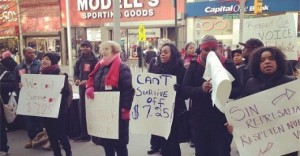February 23, 2015
by wkirkland
In one of the principle countries of the world where low, low, low wages improve the bottom line for first world companies, finally a small counter-balance to autocratic corporate rule gets a foot hold.
VF, which makes North Face and Nautica, and PVH, the parent of Calvin Klein and Tommy Hilfiger, as well as Gap, El Corte Ingles and other companies, had cut off or threatened to cut off orders from the company, the Azim Group, last year over the incidents at two of its factories in Chittagong.
But now, after weeks of negotiations, these companies have agreed to resume business with Azim because it has promised to recognize and bargain with the unions at the two factories where the violence occurred.
Azim, industry and labor officials said, has also agreed to stop efforts to oust a labor union, to pay the medical bills of a badly beaten union leader ]Mira Boashak] and to allow several union officials to return to work with full back pay.
Read all
*
And speaking of unions, Lawrence Mishel argues that lowering taxes on the working poor is not the solution to the problem of working and being poor: raising wages is, and encouraging the organizations that can bring that about – unions.
“What has hurt workers’ paychecks is not what the government takes out, but what their employers no longer put in — a dynamic that tax cuts cannot eliminate.
Between 1979 and 2014, while the gross domestic product grew 150 percent and productivity grew 75 percent, the inflation-adjusted hourly wage of the median worker rose just 5.6 percent — less than 0.2 percent a year. And since 2002, the bottom 80 percent of wage earners, including both male and female college graduates, have actually seen their wages stagnate or fall.
Protecting and expanding workers’ right to unionize and bargain collectively is also essential; the erosion of collective bargaining is the single largest factor suppressing wage growth for middle-wage workers over the last few decades. And we need to modernize our New Deal-era labor standards to include earned sick leave and paid family leave so workers can balance work and family.
Finally, stronger laws and enforcement to deter and remedy wage theft and the illegal treatment of employees as independent contractors could put tens of billions of dollars into workers’ pockets.
Contrary to conventional wisdom, wage stagnation is not a result of forces beyond our control. It is a result of a policy regime that has undercut the individual and collective bargaining power of most workers. Because wage stagnation was caused by policy, it can be reversed by policy, too.
Read all



Recent Comments